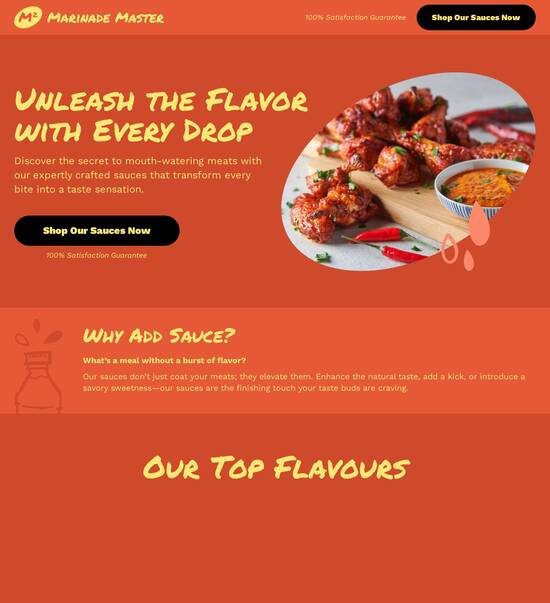
Landing page template for Digital Marketing
Use TemplateAbout template
Conquer your niche with our high-converting landing page templates for your Digital Marketing business. Let's boost conversion rates together!
Recommended templates

Easy to build without coding
With the intuitive drag-and-drop builder, anyone on your team can create high-converting pages without any knowledge of code or design. Make enhancements to your landing page with custom widgets using Javascript, HTML/CSS, or third-party scripts.

Multiple layouts for any industry and goal
Select from 500+ landing page layouts built to boost conversions across industry-specific scenarios. Customize them by adjusting fonts, adding images, and generating on-brand content with the AI assistant. Quickly scale with Instablocks® and Global Blocks that you can save, reuse, and update globally.

Loads fast and looks polished on any device
Every template is responsive, which means they present professionally on any device and load blazingly fast with our Thor Render Engine. You can also power them up with Google AMP technology to deliver an unparalleled mobile experience and drive higher conversions.

Robust analytics & experimentation
Get real-time updates and reporting across all your devices, showing the number of visitors, conversions, cost-per-visitor, and cost-per-lead. Launch AI-powered experiments, run A/B tests, and use heatmaps to analyze user behavior, then optimize your landing page to maximize conversions.







Easy to build without coding
With the intuitive drag-and-drop builder, anyone on your team can create high-converting pages without any knowledge of code or design. Make enhancements to your landing page with custom widgets using Javascript, HTML/CSS, or third-party scripts.
Multiple layouts for any industry and goal
Select from 500+ landing page layouts built to boost conversions across industry-specific scenarios. Customize them by adjusting fonts, adding images, and generating on-brand content with the AI assistant. Quickly scale with Instablocks® and Global Blocks that you can save, reuse, and update globally.
Loads fast and looks polished on any device
Every template is responsive, which means they present professionally on any device and load blazingly fast with our Thor Render Engine.
Robust analytics & experimentation
Get real-time updates and reporting across all your devices, showing the number of visitors, conversions, cost-per-visitor, and cost-per-lead. Launch AI-powered experiments, run A/B tests, and use heatmaps to analyze user behavior, then optimize your landing page to maximize conversions.
All the features you need to build digital marketing landing page
Explore more featuresLearn how to build digital marketing landing pages forms
Frequently asked questions about digital marketing landing pages
Leading the way in building high-performing landing pages





Digital marketing agency landing page template: Your ultimate how-to guide
In the fast-paced world of digital marketing, having effective landing pages is crucial for maximizing lead generation and nurturing potential customers. Instapage's collection of high-converting landing page templates offers marketers the perfect starting point to design pages that not only capture attention but also drive conversions. Here’s a step-by-step guide to help you make the most out of these templates.
Why choose Instapage landing page templates?
Instapage provides an all-in-one solution for marketers looking to enhance their campaigns with intuitive design tools. Their templates come equipped with features that cater to various industries, ensuring that you can find a design that aligns with your brand identity and marketing goals.
- Flexibility: Templates allow easy customization to match specific campaign needs.
- High conversion rates: Built with proven designs that convert visitors into leads.
- Ease of use: No coding required, making it accessible for marketers of all skill levels.
Step 1: Choose the right template for your campaign
Selecting the appropriate landing page template is crucial for your digital marketing success. Start by identifying your target audience and the specific goals of your campaign. Instapage offers over 100 templates across various sectors, including business services, technology, and education.
Step 2: Customize your landing page
After selecting a template, the next step is customization. Leverage Instapage’s intuitive drag-and-drop builder to modify elements, images, and text to fit your branding.
- Adjust colors and fonts: Ensure they align with your brand guidelines.
- Modify graphic elements: Use images that resonate with your audience.
- Incorporate clear CTAs: Call-to-action buttons should be strategically placed and visually distinct.
Step 3: Optimize for conversions
To maximize the efficiency of your landing page, leverage Instapage's optimization tools. Utilize A/B testing to see what works best for your audience and adapt your strategy accordingly.
- Use heatmaps: Analyze user interaction to improve layout and design.
- Experiment with different headlines: Test how changes can influence conversion rates.
- Monitor performance metrics: Use analytics dashboards to track page performance over time.
Creating effective landing pages is an essential part of any digital marketing strategy. By utilizing Instapage's customizable templates and optimization features, you can create high-performing pages that drive results.
Ready to enhance your digital marketing campaigns? Start utilizing Instapage's landing page templates today for immediate results!
Landing page template for digital marketing
Understanding the essence of landing pages in digital marketing
Often overlooked, landing pages play a pivotal role in digital marketing. A landing page is a standalone web page specifically designed for a marketing or advertising campaign. Unlike standard web pages that navigate to different sections of a site, landing pages are focused on a single goal such as capturing leads or driving sales. Essentially, their primary function is to convert visitors into leads or customers.
The distinction between landing pages and regular web pages lies in their purpose. Standard web pages like home pages or product pages tend to provide comprehensive information about a business or its offerings. In contrast, landing pages are targeted and concise, designed with a single intent that often aligns with a specific call to action (CTA). They cater to distinct marketing objectives, shaping visitor perception and guiding them toward making decisions that align with the campaign's goals.
The power of templates in landing page creation
Using landing page templates can significantly enhance the efficiency of the creation process. With ready-made designs, marketers can focus on strategy rather than starting from scratch. Templates can dramatically speed up development, allowing teams to launch campaigns faster and pivot as necessary. Additionally, using templates ensures consistency in design and messaging, solidifying brand identity across multiple campaigns.
High-converting templates share fundamental design elements, including eye-catching headlines, captivating images, and strategically placed forms. These components are essential for guiding a user’s journey from curiosity to conversion, as effective layouts can guide the visitor's attention seamlessly. By leveraging templates designed with best practices in mind, marketing teams can create landing pages that are not only beautiful but also effective in achieving desired outcomes.
Quick setup: Templates expedite the launch process.
Design consistency: Templates help maintain uniform brand identity.
Familiar structure: Users can intuitively navigate standard layouts.
Exploring template types for diverse marketing needs
Selecting the right landing page template can make a significant difference, depending on your marketing goals. For instance, lead capture templates are specifically designed to convert visitors into leads by encouraging them to provide their contact information. They usually feature forms prominently and include compelling copy that explains the value of submitting information.
E-commerce templates, on the other hand, are tailored to drive product sales. These pages focus on showcasing products through images and strong calls to action, encouraging visitors to make a purchase. Event registration templates serve yet another purpose, emphasizing registration forms and highlighting event details to maximize attendance. Understanding the variety of templates available allows marketers to tailor their approach effectively.
Innovative features of landing page builders
Today's landing page builders come packed with innovative features making it easier for marketers to create effective pages without needing any coding knowledge. Intuitive drag-and-drop editors eliminate technical barriers, providing users an interface where they can easily add sections, images, and forms. This flexibility allows for rapid testing and iteration, essential in the fast-paced digital landscape.
Responsive design capabilities ensure that landing pages look great across all devices, which is vital considering the increasing number of mobile users. Whether viewed on a smartphone, tablet, or desktop, these builders enable customization for every type of device. This adaptability is crucial for user experience, ensuring that visitors engage with content without encountering layout issues.
No coding required: User-friendly design editors enhance accessibility.
Customization options allow for unique branding.
Mobile optimization ensures consistency across all platforms.
A/B testing: Making data-driven decisions
A/B testing, or split testing, is a crucial strategy in optimizing landing pages. By comparing two versions of a page, marketers can identify which elements lead to higher conversion rates. For example, testing different headlines, images, or placements of call-to-action buttons can yield insights into visitor preferences that guide future design choices.
To gain meaningful insights, it’s essential to analyze results effectively. Metrics such as conversion rates and user engagement should be closely monitored to understand what resonates with your audience. This data-driven approach can help refine landing page strategies, enabling marketers to invest resources in the most successful tactics.
Compare variations: Set up tests for different page elements.
Monitor performance: Use analytics tools to understand user interactions.
Adapt strategies: Modify tactics based on findings from A/B tests.
Sections of an effective landing page
An effective landing page is structured with essential components that enhance user experience and drive conversions. Crafting a compelling headline is crucial, as it's the first thing visitors see. A well-written headline can grab attention and encourage further exploration of the page, setting the tone for what follows.
Structuring content in a clear and organized manner improves user engagement. Visual hierarchy plays a significant role here; using font sizes and colors strategically can help guide the visitor’s eye towards the most pertinent information. Including trust elements like testimonials or brand logos can boost credibility, reassuring visitors that they are in the right place.
Headlines: Make them engaging and relevant.
Content clarity: Use simple, persuasive language.
Visual elements: Balance text with images for an appealing layout.
Measuring success: Understanding conversions
Defining conversions and tracking key performance indicators (KPIs) is vital for understanding the effectiveness of landing pages. A conversion could range from a user signing up for a newsletter to completing a purchase, depending on your marketing objectives. Moreover, it's essential to track metrics beyond just clicks; engaging with user retention and engagement can also provide valuable insights into how well your landing page performs.
Integrating analytics tools enables the tracking of performance metrics comprehensively. These tools can help marketers identify which elements of a landing page are functioning effectively and which require adjustments. Continuous monitoring is vital to adapt strategies based on real-time feedback.
Define conversions: Know what actions to track.
Engagement metrics: Measure user interactions and retention.
Use analytics: Collect data to analyze performance.
Enhancing your digital presence with SEO techniques
Optimizing landing pages with SEO best practices is crucial for maximizing visibility. Conducting keyword research allows marketers to identify the terms their audience is searching for, enabling them to craft content that attracts organic traffic. Integrating these keywords naturally throughout the page can significantly impact its ability to rank higher on search engine results pages.
On-page optimization also includes honing meta tags, using headers appropriately, and ensuring images have alt text. These elements not only improve SEO ranking but also enhance usability, making your pages accessible and user-friendly. Finally, ensuring mobile responsiveness is critical, as search engines increasingly prioritize mobile-friendly designs in their ranking algorithms.
Keyword research: Identify terms relevant to your audience.
On-page elements: Optimize meta tags, headers, and alt text.
Responsive design: Ensure compatibility across devices.
Crafting a cohesive strategy across channels
Integrating landing pages with broader marketing campaigns ensures a seamless experience for users. Consistency across digital touchpoints strengthens brand identity and reinforces messaging, making it easier for visitors to connect the dots between ads, emails, and landing pages. By having cohesive visuals and messaging, marketers can bridge the gap between leads and conversions effectively.
Targeted landing pages play a key role in achieving this alignment. For instance, if a user clicks on an ad promoting a specific offer, they should be directed to a landing page that reflects the ad's content and maintains consistency. Successful campaigns leverage these principles, utilizing landing pages designed to drive conversions while ensuring that users feel they are being guided through a coherent journey.
Consistency: Align messaging and design across channels.
Seamless experience: Maintain continuity from ads to landing pages.
Utilize data: Tailor landing pages based on audience insights.
Future trends in landing page design and functionality
As technology and consumer behavior evolve, landing page design and functionality will follow suit. Predictions indicate a growing focus on personalization and user experience, with advancements in artificial intelligence paving the way. AI can enhance landing pages by automatically adapting content based on user preferences or behaviors, making interactions more relevant and engaging.
Moreover, with the increased use of voice search and smart devices, landing pages will need to be designed with these developments in mind. This could involve more conversational tones in copy and adaptive designs that cater to various screen sizes. Marketers must remain agile and ready to adapt to these incoming trends to ensure relevance and effectiveness.
Emphasis on personalization: Tailor experiences to user preferences.
Integration of AI: Enhance interaction and content relevance.
Adaptability: Prepare for evolving technology and user behaviors.
Ready to skyrocket conversions?
Supercharge your ad campaigns with high-performing landing pages
Get started














